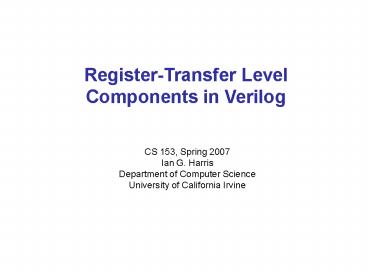Register-Transfer Level Components in Verilog - PowerPoint PPT Presentation
Title:
Register-Transfer Level Components in Verilog
Description:
Need to reimplement the Div/Mod structurally, not behaviorally. Build it using RTL (datapath) components ... Fixed length loops can be implemented with down ... – PowerPoint PPT presentation
Number of Views:64
Avg rating:3.0/5.0
Title: Register-Transfer Level Components in Verilog
1
Register-Transfer Level Components in Verilog
CS 153, Spring 2007 Ian G. Harris Department of
Computer Science University of California Irvine
2
Next Assignment Div/Mod, Structurally
- Need to reimplement the Div/Mod structurally, not
behaviorally - Build it using RTL (datapath) components
- Need to determine how to implement behavioral
operations structurally
- Some tips
- Fixed length loops can be implemented with down
counters and zero detectors - Left/right shift can be implemented using shift
registers - Assignments within conditionals can be
implemented using multiplexers to drive registers
if (x gt y) z 1 else z 0
3
RTL Components
- Built from gates and flip-flops
- Operate on words rather than bits
- Some are combinational, some are sequential
- Data inputs vs. control inputs
- Data outputs vs. status outputs
Example 8 bit ALU Inputs - in1 70, in270,
op30 Outputs - out70, cout
4
RTL Component Design
- Define your RTL components behaviorally, not
structurally - Combine RTL components structurally to create a
larger design
Example 4 to 1 Multiplexer
module mux4to1 (W, S, f) input 03 W, 10
S output f reg f always _at_(W or S) case (S)
0 f W0 1 f W1 2 f
W2 3 f W3 endcase endmodule
5
Sequential Components
module reg8 (D, Clock, Resetn, Q) input 70
D, Clock, Resetn output 70 Q reg 70
Q always _at_(negedge Resetn or posedge Clock)
if (!Resetn) Q lt 0 else
Q lt D endmodule
- Reset is negatively asserted
- You can add a clear or a shift function as needed
6
Components needed for a Div/Mod
- Register, 8 bit, needs a load signal
- Shift register, 8 or 16 bit, needs a load signal
- Subtractor, 8 bit
- Comparator
- Multiplexer, 8 bit, 2 way
- Counter - to stop after 8 iterations
- Comparator (or zero detector) - to detect last
iteration
- Notice that Div/Mod is sequential
- Your testbench will need to generate a clock































